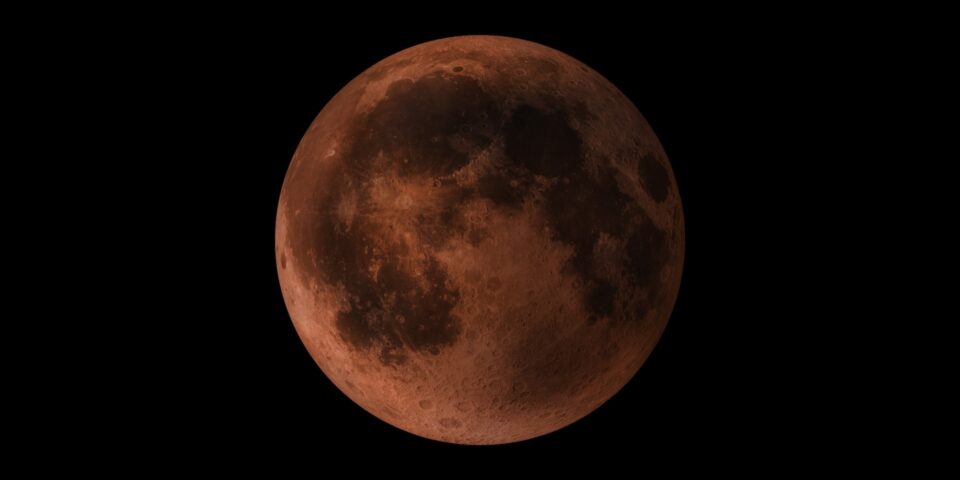Skywatchers across India witnessed a total lunar eclipse – the rare Blood Moon – on the night of September 7, 2025. This event, known for turning the moon a coppery-red color, was a vivid display of our solar system in motion.
What Time Did It Blood Moon Happen?
The eclipse began subtly at 9:57 PM IST as the Earth’s shadow started to creep across the Moon’s surface. This partial phase progressed until the moment of totality, when the Moon became entirely engulfed in shadow, beginning at 11:01 PM IST.
For the next 82 minutes, the moon stayed within the deepest part of Earth’s shadow, glowing red. This total phase ended at 12:23 AM on September 8. After that, the moon slowly moved out of the shadow, with the partial eclipse finishing at 1:26 AM. The whole event was over by 2:25 AM.
Why Did the Moon Turn Red? – The Science
During a total lunar eclipse the most breathtaking moment occurs when the moon turns into a deep coppery-red sphere. The Earth blocks direct sunlight from reaching the lunar surface when it stands between the Sun and the Moon thus producing this spectacular color. The Earth’s atmosphere acts as a filter which scatters blue light wavelengths while allowing red wavelengths to reach the moon.
The Earth’s atmosphere functions as a lens which scatters blue light wavelengths while passing red wavelengths to the moon. The red light which passes through our planet’s atmosphere creates a warm illumination that shines on the moon. The same process which creates sunset and sunrise colors in our skies produces this effect.
The red color appearance during eclipses appears different each time the event occurs. It can range from a bright copper to a dark, rusty blood red, all depending on what’s in the Earth’s atmosphere at that moment. Factors like dust, cloud cover, or even ash from a recent volcanic eruption high in the atmosphere play a role in creating the final color.
How Was the Viewing in India?
The eclipse was visible from everywhere in India, but the weather didn’t cooperate for everyone. Monsoon clouds and rain blocked the view in many places.
For those with clear skies, it was a beautiful and enthralling sight. You could watch the Earth’s shadow slowly move across the moon, and during the total phase, the darkened sky was the perfect background for the stars, making them more visible.
Luckily, nobody had to miss out as The Indian Institute of Astrophysics live-streamed the eclipse from its observatories in Bengaluru, Ladakh, and Tamil Nadu. Astronomy clubs around the world also shared their feeds online.
When Can We See the Next One?
This eclipse wasn’t just visible from India. People across Asia, Europe, Africa, and western Australia could see it too. For people in India, it was the first one since 2018 that could be seen from the entire country.
We don’t get an eclipse every full moon because the moon’s orbit is tilted. The sun, earth, and moon need to line up perfectly, which only happens now and then.
The next total lunar eclipse can be seen from India on December 31, 2028.
A Safe and Easy Event to Watch
The best part? Lunar eclipses are completely safe to watch. You can observe the eclipse through your unaided eyes by simply looking up at the sky from outside.
The event becomes more special when you observe it through binoculars or a small telescope. Through your observation you will see the Earth’s shadow move across specific lunar craters and seas which will expose remarkable surface details.
Wrapping Up
The September 7th eclipse brought a unique experience to everyone who observed it. The event brought together exact timing with basic scientific principles to create a common viewing experience for all sky observers despite the presence of clouds. The solar system maintains its regular patterns which we can expect to see again during the December 31st 2028 eclipse.
FAQs
What is a Blood Moon and why did the Moon turn red?
A Blood Moon happens during a total lunar eclipse when the Earth comes between the Sun and the Moon, blocking sunlight. The Earth’s atmosphere scatters blue light and allows red light to pass through, giving the Moon a deep coppery-red color, similar to the colors seen during sunsets.
What exactly is a Blood Moon?
Blood Moon is the name given to the Moon when it turns red during a total lunar eclipse. This happens because Earth blocks sunlight, and only red light passes through Earth’s atmosphere to reach the Moon.
When will the next total lunar eclipse be visible from India?
The next total lunar eclipse visible from India will occur on December 31, 2028. Lunar eclipses happen only when the Sun, Earth, and Moon align perfectly, which doesn’t occur every full moon.

